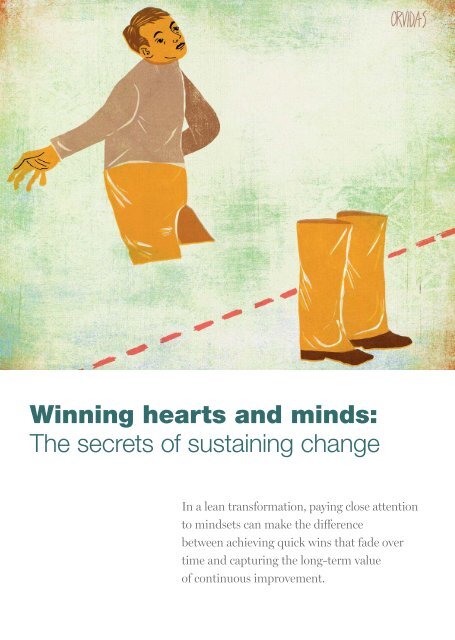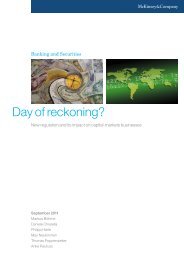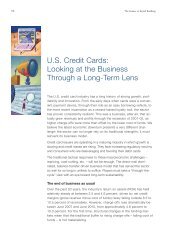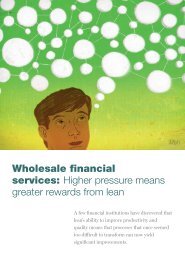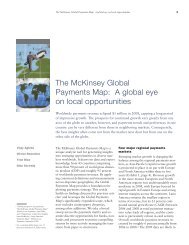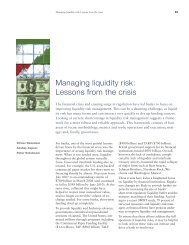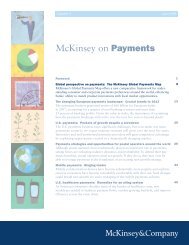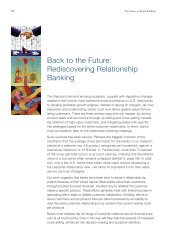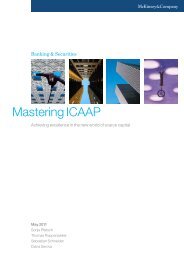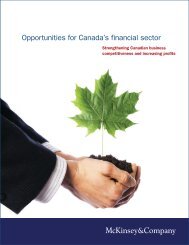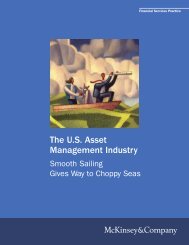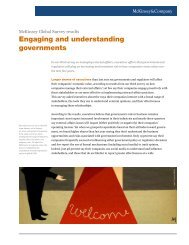Winning hearts and minds - McKinsey & Company
Winning hearts and minds - McKinsey & Company
Winning hearts and minds - McKinsey & Company
You also want an ePaper? Increase the reach of your titles
YUMPU automatically turns print PDFs into web optimized ePapers that Google loves.
46 Lean Management New frontiers for financial institutions<br />
<strong>Winning</strong> <strong>hearts</strong> <strong>and</strong> <strong>minds</strong>:<br />
The secrets of sustaining change<br />
In a lean transformation, paying close attention<br />
to <strong>minds</strong>ets can make the difference<br />
between achieving quick wins that fade over<br />
time <strong>and</strong> capturing the long-term value<br />
of continuous improvement.
Carolyn Aiken,<br />
Dmitriy Galper,<br />
<strong>and</strong> Scott Keller<br />
This article is adapted from<br />
Carolyn Aiken <strong>and</strong> Scott<br />
Keller, “The inconvenient<br />
truth about change<br />
management: Why it isn’t<br />
working <strong>and</strong> what to<br />
do about it,” <strong>McKinsey</strong><br />
& <strong>Company</strong>, May 2008.<br />
Organizations that embark on a lean<br />
transformation underst<strong>and</strong>ably have high hopes.<br />
Fixing broken processes, eliminating activities<br />
that don’t add value, creating more fulfilling jobs,<br />
<strong>and</strong> delegating more power to the front line all<br />
hold out the promise of a better way of working<br />
<strong>and</strong> a more successful enterprise. Most lean efforts<br />
deliver early wins that unleash energy <strong>and</strong> build<br />
confidence. Yet these initial successes do not<br />
always translate into sustainable improvements.<br />
When we asked European financial institutions<br />
to assess their own large scale transformations,<br />
fewer than 40 percent rated their program<br />
as successful as they would have liked over the<br />
long term. <strong>McKinsey</strong> research into change<br />
programs across a range of sectors suggests that<br />
the difficulty organizations have in sustaining<br />
change can be traced to insufficient attention paid<br />
to the attitudes <strong>and</strong> behaviors of managers <strong>and</strong><br />
employees. These people-related factors were<br />
responsible for more poor outcomes than were the<br />
usual suspects—inadequate budgets or badly<br />
targeted resources. The reshaping of employee<br />
attitudes <strong>and</strong> behaviors is just as critical to the<br />
success of a transformation as the implementation<br />
of process changes.<br />
The perception that behavior is a “soft” topic leads<br />
managers to assume they can rely on their<br />
own instincts, an approach that seldom leads<br />
to sustainable long-term change. Instead,<br />
managers need to take the time to underst<strong>and</strong><br />
some of the factors that influence human<br />
behavior. In our experience, organizations that<br />
have achieved true behavioral change in the<br />
context of a lean transformation have incorporated<br />
six often-overlooked insights.<br />
1. People need to feel that change matters<br />
Most financial institutions implementing<br />
lean transformations tell one of two classic change<br />
stories to motivate their people. The first—<br />
which we might call “good to great”—portrays<br />
financial services as an increasingly competitive<br />
sector in which customers are dem<strong>and</strong>ing<br />
better <strong>and</strong> better service, thus requiring the<br />
organization to change in order to recapture<br />
its leadership position. The other classic<br />
story is the turnaround, which says that the<br />
institution is performing below industry<br />
st<strong>and</strong>ards <strong>and</strong> must transform itself to survive.<br />
47<br />
Despite their apparent logic, these narratives lack<br />
the power to motivate real change. They primarily<br />
address the institution itself: how it can<br />
beat the competition, push performance to<br />
the next level, pursue industry leadership, <strong>and</strong> so<br />
on. But research by leading social scientists<br />
shows that most people are motivated to change<br />
by influences coming from beyond the organization.<br />
These include the customer, society at<br />
large, the working team, <strong>and</strong> the interests of the<br />
individual employee. If the change story is focused<br />
only on the organization, it is unlikely to inspire<br />
heartfelt commitment to the transformation.<br />
The good news is that lean transformations are<br />
capable of delivering multiple benefits to<br />
multiple stakeholders. Lean processes eliminate<br />
frustrating rework for employees <strong>and</strong> boost<br />
satisfaction for customers. The introduction<br />
of work cells enables colleagues to communicate<br />
more effectively <strong>and</strong> achieve goals through<br />
closer teamwork. Coaching helps employees<br />
perform better while addressing their career<br />
development needs. A strong change story<br />
will stress the benefits that lean can bring to<br />
individual employees, teams, customers,<br />
<strong>and</strong> the wider community, as well as to the institution<br />
itself. In effect, by “telling five stories<br />
at once,” senior leaders can unleash substantial<br />
organizational energy that would otherwise<br />
remain dormant.<br />
When a large US financial services company<br />
embarked on a cost-reduction program,<br />
it devised a change story that ticked all the boxes<br />
of conventional change management wisdom.<br />
Even so, 3 months on, employee resistance<br />
was holding the program back. So the team recast<br />
the story to include elements relating to society
48 Lean Management New frontiers for financial institutions<br />
(providing affordable services for affordable<br />
housing), customers (increasing simplicity<br />
<strong>and</strong> flexibility, reducing errors, making prices<br />
more competitive), the company (slowing<br />
unsustainable growth in expenses), working teams<br />
(reducing duplication, increasing delegation,<br />
promoting accountability), <strong>and</strong> individuals<br />
(creating jobs with broader scope). This simple<br />
shift boosted employee motivation within weeks.<br />
2. Change must be seen as fair<br />
Making employees care about change <strong>and</strong> want<br />
to contribute to it is one challenge; another<br />
is to make sure that change is considered fair.<br />
Whenever an organization makes changes to its<br />
structures, processes, systems, <strong>and</strong> incentives,<br />
it should always pay attention to employees’ sense<br />
of the fairness of the change process as well<br />
as its outcome. Particular care should be taken<br />
when changes affect the way employees interact<br />
with one another (such as headcount reductions<br />
or changes to talent management practices)<br />
<strong>and</strong> with customers (such as sales stimulation<br />
programs or pricing changes).<br />
Change stories should<br />
explain lean’s benefit to<br />
employees, teams, customers,<br />
<strong>and</strong> the community—<br />
not just to the institution.<br />
A bank undertaking a major change program discovered<br />
that its pricing did not adequately<br />
reflect the credit risk it was taking on, so management<br />
created new risk-adjusted rate of return<br />
models <strong>and</strong> pricing schedules. At the same time, it<br />
modified sales incentives to reward customer<br />
profitability rather than volume. The rationale for<br />
these changes was not sufficiently delivered to<br />
the front line, <strong>and</strong> the effect was disastrous.<br />
Customers—<strong>and</strong> not just the unprofitable ones—<br />
deserted in droves, <strong>and</strong> price over-rides went<br />
through the roof.<br />
To underst<strong>and</strong> what went wrong, we need to<br />
appreciate that people will act against<br />
their own self-interest if a situation violates their<br />
sense of how the world should work, especially<br />
where fairness <strong>and</strong> justice are concerned.<br />
When the bank raised its prices, frontline<br />
staff thought it was unfair—a case of executives<br />
getting greedy <strong>and</strong> losing sight of customer<br />
service. Some bankers even told their customers<br />
how they felt about the new policy, siding<br />
with their customers rather than their employer<br />
even though this put their personal sales goals<br />
at risk. Many bankers used price over-rides<br />
to show good faith to customers <strong>and</strong> take revenge<br />
on the “greedy” executives.<br />
Paradoxically, the bankers’ sense of unfairness<br />
was misplaced: the new pricing system,<br />
in which customers were asked to pay a price<br />
commensurate with the risk the bank was<br />
taking on, was inherently fair. The downward<br />
spiral of bad feeling, lost customers, <strong>and</strong><br />
price over-rides could have been avoided if the<br />
training <strong>and</strong> communications accompanying<br />
the changes had made this fact clear to employees.<br />
Another bank ran into difficulties when it rationalized<br />
its IT support services. Formerly, field<br />
workers needing IT help simply turned to a nearby<br />
technician, a practice that led to unnecessary<br />
work <strong>and</strong> made it difficult to track productivity or<br />
plan workloads. As part of its lean effort, the<br />
bank required people seeking IT support to call
1 John Whitmore, Coaching<br />
for Performance: Growing<br />
people, performance <strong>and</strong><br />
purpose (Nicholas Brealey,<br />
3rd edition, 2002).<br />
<strong>Winning</strong> <strong>hearts</strong> <strong>and</strong> <strong>minds</strong>: The secret of sustaining change<br />
the help desk first. When workers complained to<br />
the field technicians, they replied that the<br />
procedure was part of corporate’s plan to cut<br />
service levels.<br />
To set the record straight, the bank explained to<br />
staff that the new system would speed up<br />
service as well as reduce costs. A technician would<br />
respond within 1 day (compared with 3 days<br />
under the old system), <strong>and</strong> real emergencies would<br />
be h<strong>and</strong>led immediately. Once staff understood<br />
the benefits of the new system <strong>and</strong> saw that it<br />
worked, the grumbling died down.<br />
3. Positive feedback <strong>and</strong> active learning<br />
help make change last<br />
Most organizations take a “deficit-based”<br />
approach to implementing change: they focus on<br />
defining a problem, analyzing its causes,<br />
identifying feasible solutions, then developing<br />
<strong>and</strong> implementing an action plan. This<br />
approach seems so sensible that it is hard to<br />
underst<strong>and</strong> why it might not be effective.<br />
Yet motivational research shows that focusing on<br />
what is wrong invites blame, causes fatigue,<br />
builds resistance, <strong>and</strong> fails to draw on people’s<br />
passions <strong>and</strong> experience. University of Wisconsin<br />
researchers illustrated the value of positive<br />
feedback after filming two bowling teams. They<br />
gave the teams different videos to review:<br />
one showing only mistakes, the other showing<br />
only successes. The team that reviewed its<br />
own successes was able to improve its performance<br />
far more than the team that reviewed only<br />
its own errors.<br />
Focusing on the positive aspects is the best<br />
approach to promote change. Lean transformation<br />
teams can act on this insight by emphasizing<br />
the added value that process changes will<br />
create for customers <strong>and</strong> the greater employee<br />
engagement that will come from eliminating<br />
needless rework, duplication, <strong>and</strong> complexity.<br />
Another way to promote behavioral change is to<br />
engage people in active learning right from<br />
49<br />
the outset. Adults attending lectures, presentations,<br />
<strong>and</strong> discussions—i.e., learning by listening—<br />
typically retain just 10 percent of the material<br />
after 3 months. Learning by doing—taking<br />
part in role plays <strong>and</strong> simulations <strong>and</strong> putting lean<br />
to work in a “model office” setting—boosts<br />
retention rates to 65 percent. When people have<br />
an immediate opportunity to put what they<br />
have learned into practice in their workplace,<br />
retention can approach 100 percent. �<br />
Lean skill-building programs can capitalize<br />
on this insight by adopting a “field <strong>and</strong> forum”<br />
approach that intersperses classroom learning<br />
with frequent fieldwork assignments linked<br />
directly to employees’ jobs. These assignments<br />
provide opportunities to apply new thinking<br />
<strong>and</strong> skills in relevant <strong>and</strong> meaningful ways, <strong>and</strong><br />
make learning a much more efficient <strong>and</strong><br />
rewarding experience. At the executive <strong>and</strong><br />
management level, on-the-job learning is often<br />
facilitated by coaching. Sometimes this takes<br />
place in a confidential one-to-one setting;<br />
in other cases, coaches sit with managers during<br />
everyday tasks, observe how they h<strong>and</strong>le<br />
interactions with their staff, <strong>and</strong> provide immediate<br />
feedback. Organizations can further enhance<br />
learning by introducing quantifiable performance<br />
measures to track competency growth, <strong>and</strong><br />
setting up certification <strong>and</strong> rewards to recognize<br />
new skills. When leaders treat training as<br />
an ongoing part of career development rather than<br />
isolated events that end on the last day of class,<br />
they also have a better chance of engaging their<br />
employees in making continuous improvements<br />
in the way they work—one of the key benefits<br />
of lean management.<br />
4. Changing behavior means<br />
changing <strong>minds</strong>ets<br />
Some managers believe that employees’ thoughts,<br />
feelings, <strong>and</strong> beliefs are their own private<br />
business, <strong>and</strong> not a suitable subject for discussion<br />
in the workplace. But people’s inner lives<br />
inform their behavior. If leaders want to change<br />
how their employees work, they need to
50 Lean Management New frontiers for financial institutions<br />
Exhibit 1<br />
The business impact of performance culture.<br />
% improvement<br />
Bank 1<br />
Profit per business<br />
banker<br />
Bank 2<br />
Retail banker<br />
cross-selling ratio<br />
Retailer<br />
Sales-to-labor<br />
ratio<br />
Telco<br />
Churn reduction<br />
appreciate why people act the way they do<br />
<strong>and</strong> underst<strong>and</strong> how influencing their<br />
<strong>minds</strong>ets can help them change their behavior.<br />
To see how this works in a lean transformation,<br />
consider one bank that learned its sales<br />
per banker were well below the industry benchmark.<br />
The bankers claimed that mounting<br />
paperwork left little time for customer interaction.<br />
So the bank gave its bankers new sales scripts,<br />
easy-to-use tools, <strong>and</strong> additional training to<br />
reduce the need for paperwork. Problem solved?<br />
Not at all. Six months later, the hoped-for<br />
improvements in sales had failed to materialize.<br />
Close investigation revealed that most of the<br />
bankers felt uncomfortable interacting<br />
with customers, <strong>and</strong> preferred doing paperwork.<br />
Many had introverted personalities <strong>and</strong><br />
poor interpersonal skills, <strong>and</strong> found that dealing<br />
with wealthier <strong>and</strong> more educated customers<br />
made them feel inferior. To make matters worse,<br />
most of the supervisors were drawn from the<br />
bankers’ ranks <strong>and</strong> shared their outlook. Although<br />
the outward environment had been changed<br />
to make it easier for bankers to spend more time<br />
8<br />
19<br />
19<br />
34<br />
35<br />
43<br />
Traditional pilot Pilot using cultural interventions<br />
51<br />
with customers, the bankers’ own <strong>minds</strong>ets<br />
prevented them achieving this goal.<br />
Once it understood this barrier, the company<br />
introduced training to help staff explore<br />
topics such as personality types, emotional intelligence,<br />
<strong>and</strong> vocational identity. The training<br />
helped people to realize that they can learn<br />
to change how they act at work even if the new<br />
behavior does not come naturally to them<br />
at first. Management also sought to present sales<br />
in a new light, as a noble pursuit helping customers<br />
to discover <strong>and</strong> fulfill their unexpressed<br />
needs. Within six months, the program was<br />
back on track <strong>and</strong> generating sustainable sales<br />
gains well above the original targets.<br />
Underst<strong>and</strong>ing <strong>and</strong> influencing employees’ <strong>minds</strong>ets<br />
is sometimes seen as a “soft” subject with<br />
little real business impact. Yet when organizations<br />
create an environment that motivates employees<br />
to work to their full potential—what we<br />
describe as a “performance culture”—they achieve<br />
considerably better bottom-line results. Exhibit 1<br />
illustrates the impact of a set of pilots conducted<br />
in companies undergoing change programs.<br />
65
<strong>Winning</strong> <strong>hearts</strong> <strong>and</strong> <strong>minds</strong>: The secret of sustaining change<br />
Some pursued traditional approaches; others used<br />
cultural interventions to address employee<br />
<strong>minds</strong>ets <strong>and</strong> behaviors. The second group<br />
outperformed the first on every measure. Because<br />
both sets of interventions were carried out<br />
in the same companies at the same time, they<br />
provide compelling proof that paying attention to<br />
employees’ <strong>minds</strong>ets generates tangible benefits.<br />
5. People won’t change unless their<br />
leaders do<br />
Most senior executives believe in leading by example.<br />
Encouraged by HR professionals <strong>and</strong><br />
consultants, they commit themselves to rolemodeling<br />
behaviors targeted by the transformation<br />
effort. Yet all too often their efforts bear<br />
little fruit. A common difficulty is that leaders<br />
don’t consider themselves to be part of the<br />
problem, <strong>and</strong> have little motivation to alter their<br />
51<br />
behavior. Most hard-working <strong>and</strong> well-intentioned<br />
executives believe they are doing the right<br />
thing already. They may recognize that their<br />
organization is low in trust, bureaucratic,<br />
<strong>and</strong> lacking in customer focus, for instance, while<br />
failing to see how their own actions contribute<br />
to these shortcomings.<br />
Accordingly, many institutions use 360-degree<br />
feedback techniques in surveys or discussions<br />
to shed light on areas where leaders’ <strong>minds</strong>ets <strong>and</strong><br />
behaviors might represent barriers to change.<br />
Engaging an objective observer to sit in on<br />
meetings <strong>and</strong> analyze day-to-day activities in the<br />
executive calendar can also be a great help<br />
to leaders in underst<strong>and</strong>ing how they spend their<br />
time <strong>and</strong> manage others. A CEO who is trying<br />
to improve customer focus but spends no time<br />
meeting customers is not sending the right
52 Lean Management New frontiers for financial institutions<br />
message to the rest of the organization. Nor is<br />
a leader who claims not to be bureaucratic<br />
but holds meetings that spawn yet more meetings<br />
without ever reaching decisions.<br />
To focus attention on behaviors that needed modification,<br />
one global bank asked managers to<br />
complete self-assessments on specific lean-related<br />
topics <strong>and</strong> had subordinates rate the managers<br />
on these topics anonymously. The combined<br />
assessments, which were made quarterly, allowed<br />
managers to see how far they had to go to<br />
achieve program goals <strong>and</strong> focused their attention<br />
on the desired behaviors. Such techniques<br />
can be highly effective in holding up a mirror to<br />
leaders <strong>and</strong> helping them overcome their<br />
personal behavioral challenges (See “Building<br />
lean leaders,” p. 60).<br />
Leaders apart, a few employees in most organizations<br />
exert disproportionate influence<br />
over the behavior of others. Conventional change<br />
management wisdom recommends enlisting<br />
these “influencers” to ignite behavioral change.<br />
But we would advise caution: the reach of<br />
influencers is often narrower than organizations<br />
might imagine, <strong>and</strong> engaging them in sufficient<br />
numbers to make a real difference can be<br />
costly. Experience suggests that success depends<br />
less on influencer persuasiveness <strong>and</strong> more on<br />
the receptiveness of the target audience.<br />
6. Personal involvement creates<br />
ownership <strong>and</strong> impact<br />
Most leaders realize that they need to devote<br />
a great deal of time to communicating<br />
their change stories to employees through road<br />
shows, town-hall forums, blogs, intranets,<br />
<strong>and</strong> other approaches. But effective communication<br />
is a two-way process. Only by listening<br />
to employees as well as speaking to them<br />
can managers make the organization’s change<br />
story compelling.<br />
The CEO at a division of a UK-based bank<br />
drafted a change story <strong>and</strong> asked his<br />
top team for their feedback. He also asked each<br />
team member to write a change story for<br />
their own department that would support his<br />
broader story. This process was repeated<br />
at progressively lower levels until it reached<br />
the front line. Although it took a long time<br />
to cascade these multiple change stories,<br />
the process produced stories that were relevant<br />
to employees <strong>and</strong> engendered tremendous<br />
commitment to the program.<br />
People need to feel actively involved not only in<br />
making change happen but in deciding<br />
what to change <strong>and</strong> how to make the working<br />
environment more efficient <strong>and</strong> effective.<br />
Flatly telling employees what to do <strong>and</strong> leaving<br />
them to it is demotivating: it imparts no<br />
ownership of the initiative, while undermining<br />
personal involvement <strong>and</strong> discovery.<br />
Applying this insight in a lean setting can have<br />
a powerful impact. Consider the daily huddles<br />
that many financial institutions hold around<br />
visual performance boards to discuss today’s<br />
targets, yesterday’s results, ongoing challenges,<br />
<strong>and</strong> ideas for tackling them. In a non-lean setting,<br />
topics like these would probably be aired in<br />
a formal meeting with a team leader or department<br />
head leading the discussion <strong>and</strong> telling<br />
subordinates what to do. In a lean organization,<br />
by contrast, the huddle is a forum for brainstorming<br />
<strong>and</strong> joint problem solving, <strong>and</strong> the<br />
discussion can be led by any team member. Their<br />
role is not to provide answers or delegate tasks,<br />
but to ask good questions, motivate colleagues<br />
around shared targets, <strong>and</strong> encourage new<br />
thinking to solve recurring problems. Rotating the<br />
leadership of the huddle gives team members<br />
an opportunity to develop leadership skills as well<br />
as the satisfaction of contributing to a more<br />
effective working environment.
<strong>Winning</strong> <strong>hearts</strong> <strong>and</strong> <strong>minds</strong>: The secret of sustaining change<br />
Many financial institutions have had success<br />
using lean programs to deliver short-term<br />
improvement goals, but sustaining the change<br />
is often more difficult. A well-informed<br />
approach to engaging employees in the process<br />
of change can help lean programs reach<br />
beyond short-term success to become a long-term<br />
enabler of sustainable competitive advantage.<br />
Leaders that act on the six insights we have<br />
discussed will st<strong>and</strong> a better chance of engaging<br />
their employees <strong>and</strong> unleashing the energy to<br />
make real change in their organizations.<br />
Carolyn Aiken is a principal in <strong>McKinsey</strong>’s Toronto<br />
office, Dmitriy Galper is an associate principal<br />
in the Munich office, <strong>and</strong> Scott Keller is a director in<br />
the Los Angeles office. Copyright © 2011 <strong>McKinsey</strong><br />
& <strong>Company</strong>. All rights reserved.<br />
53<br />
Further reading<br />
David Fine, Maia A. Hansen, <strong>and</strong> Stefan Roggenhofer, “From<br />
lean to lasting: Making operational improvements stick,”<br />
<strong>McKinsey</strong> Quarterly, November 2008.<br />
Jeffrey Pfeffer <strong>and</strong> Robert I. Sutton, “Change or die?:<br />
An evidence-based approach to change management,”<br />
Harvard Business Review, March 2006.<br />
Jim Collins, How the Mighty Fall: And Why Some Companies<br />
Never Give In, R<strong>and</strong>om House, 2009.<br />
Scott Keller <strong>and</strong> Colin Price, Performance <strong>and</strong> Health:<br />
An Evidence-Based Approach to Transforming Your<br />
Organization, <strong>McKinsey</strong> & <strong>Company</strong>, 2010.<br />
Scott Keller, Mary Meaney, <strong>and</strong> Caroline Pung, “What<br />
Successful Transformations Share: <strong>McKinsey</strong><br />
Global Survey Results,” <strong>McKinsey</strong> Quarterly, March 2010.
We welcome your comments <strong>and</strong> questions:<br />
We welcome your comments <strong>and</strong> questions:<br />
Americas<br />
Andy Eichfeld<br />
1200 Nineteenth Street NW, Suite 1000<br />
Washington, DC 20036<br />
United States<br />
+1 (202) 662-3341<br />
Andy_Eichfeld@mckinsey.com<br />
Francisco Ortega<br />
Avenida Le<strong>and</strong>ro N. Alem 855—piso 24<br />
C1001AAD Buenos Aires<br />
Argentina<br />
+54 (11) 5 776 3817<br />
Francisco_C_Ortega@mckinsey.com<br />
Rami Karjian<br />
1420 Fifth Avenue, Suite 3100<br />
Seattle, WA 98101<br />
United States<br />
+1 (206) 393-6491<br />
Rami_Karjian@mckinsey.com<br />
Europe<br />
David Jacquemont<br />
79, Avenue des Champs-Elysées<br />
75008 Paris<br />
France<br />
+33 (1) 40 69 93 63<br />
David_Jacquemont@mckinsey.com<br />
Jaap Versfelt<br />
Amstel 344<br />
1017 AS Amsterdam<br />
The Netherl<strong>and</strong>s<br />
+31 (20) 551 3034<br />
Jaap_Versfelt@mckinsey.com<br />
Marc Niederkorn<br />
40 Avenue Monterey<br />
2163 Luxembourg<br />
Luxembourg<br />
+352 (26) 56 46 11<br />
Marc_Niederkorn@mckinsey.com<br />
Paul Jenkins<br />
Olav V’s gate 5<br />
PO Box 1683, Vika<br />
N-0120 Oslo<br />
Norway<br />
+47 (22) 86 2656<br />
Paul_Jenkins@mckinsey.com<br />
Thierry Nautin<br />
79, Avenue des Champs-Elysées<br />
75008 Paris<br />
France<br />
+33 (1) 40 69 95 01<br />
Thierry_Nautin@mckinsey.com<br />
Middle East <strong>and</strong> Asia<br />
Driek Desmet<br />
#18-03 Centennial Tower, 3 Temasek Avenue<br />
Singapore 039190<br />
Singapore<br />
+65 6586 4986<br />
Driek_Desmet@mckinsey.com<br />
Joydeep Sengupta<br />
2903, Al Moosa Tower II<br />
Sheikh Zayed Road<br />
PO Box 33538<br />
Dubai<br />
United Arab Emirates<br />
+971 (4) 312 4692<br />
J_Sengupta@mckinsey.com


